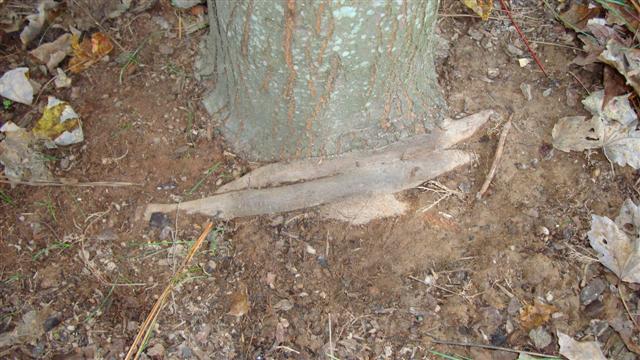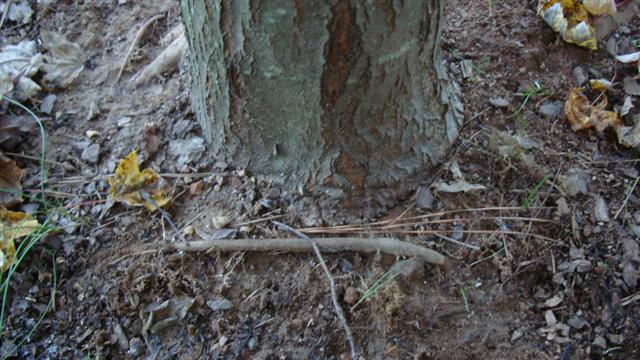Ask An Arborist: January 7, 2010
 |
 |
|
Images Submitted by Reader |
Andy in Tucker Writes...
"I just noticed some girdling roots at base of my maple tree. The roots are embedded/impacted into the root crown of the tree.
This year the tree is losing leaves in waves without the leaves turning red. I don't know if the flood or the girdling roots has
caused this."
I posed this question to Art Morris, Board Certified Master Arborist with Bartlett Tree Experts.
His Answer Is...
It looks like Andy noticed these girdling roots before they began to cause
serious damage to his red maple. Girdling roots are a very common and often
overlooked landscape problem, especially on maple trees. We've all seen
the roots circling around the inside of a plant's container when we bring
it home from the nursery or garden center. These "circling roots"
can easily become girdling roots. If circling roots are not corrected at
planting time, the tree trunk grows and eventually comes into contact with
the roots. Over time, these roots begin to strangle the tree trunk (girdling)
and limit water and nutrient uptake, often killing the tree.
From the pictures it looks like Andy's red maple is about 8 inches in diameter
and the offending roots are perhaps 1 or 2 inches diameter, so it's still
okay to cut them off. As a general rule, it's best to remove girdling roots
as long as they're less than one third of the tree trunk diameter (for
trees less than 12 inches diameter). I also recommend that Andy excavate
the soil around the base of the tree to expose the root flare and check
for any other offending roots. Consider testing the soil and fertilizing
the tree (this spring) to make sure it has adequate nutrients after the
removal of the roots.
Proper planting depth is a key to avoiding girdling roots. Trees should be planted with the root collar slightly above the
native soil grade. Planting too deep can lead to girdling roots and other problems. Make sure to disturb the root ball of new
transplants to identify the root collar and to check for circling roots. If you have young trees in your landscape it's a good
idea to check them too; make sure to remove any excessive mulch or soil from the area around the base of the tree.
My thanks go to Art Morris of
Bartlett Tree Experts for answering this question.
For More Information
For more information on how to properly plant trees, Dr. Kim Coder at the University of Georgia has a wonderful online
publication with diagrams entitled
"Plant Trees Right."
If you are concerned about the trees in your landscape, you can contact a Certified Arborist or a professional tree company in
your area through the web site of the
Georgia Arborist Association.
If you have comments or questions about this article or want to submit a question that may be used in a future article, please
email me.
Unless otherwise noted, Images & Drawings Copyrighted © 2010 by Theresa Schrum - All rights reserved



